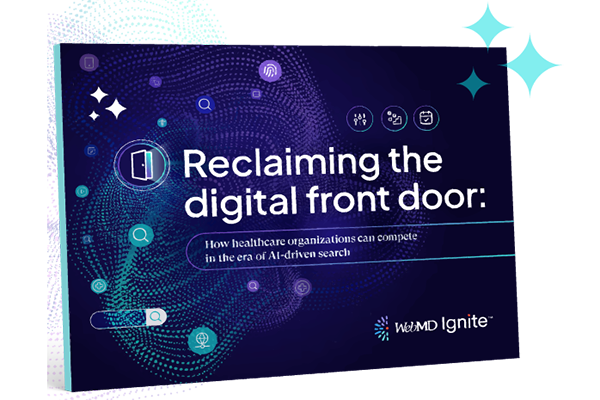How is the patient experience different from patient satisfaction?

Categories: health plans, health systems, healthcare organizations, associations
Tags: Build loyalty
Patient experience is an important healthcare industry concept to understand, yet it is often confused with patient satisfaction. The two terms are not interchangeable, however. And while these phrases may seem self-explanatory, there’s quite a bit of underlying context to both patient satisfaction and patient experience that healthcare professionals should know.
Patient experience spans more than a clinical encounter, just as patient satisfaction goes beyond whether patients will remain loyal to their provider or health system. Measuring both patient experience and patient satisfaction has become a major priority for healthcare organizations in recent years, especially as patient-centered care initiatives are increasing. In brief, patient experience is associated with a patient’s perception of care, while patient satisfaction is about the patient’s expectations for care.
What is patient experience?
There is no standardized definition of patient experience across health systems and clinical environments. In general, patient experience refers to the wide range of interactions patients have with the healthcare system. It can include: the patient’s passive perception of your brand. The care and communication provided by clinicians, nurses, staff, health plans, and other relevant parties. Or non-clinical elements like the quality of food, amount of parking, typical wait times, or online scheduling capabilities. In summary, the patient experience is the sum of every major and minor interaction with your health system.
Despite how broad the patient experience can be, many organizations have managed to articulate the scope of the patient experience concisely. According to the Agency for Healthcare Research and Quality (AHRQ), “patient experience includes several aspects of healthcare delivery that patients value highly when they seek and receive care, such as getting timely appointments, easy access to information, and good communication with healthcare providers.”
The Beryl Institute provides an even more concise definition: “Patient experience is the sum of all interactions, shaped by an organization’s culture, that influence patient perceptions, across the continuum of care.” This definition includes elements of active as well as passive participation on the part of the patient and the health system, along with preconceived notions, expectations, and cultural values that come into play.
The patient experience is a measurable concept, although accurately tracking it can be difficult due to the subjective nature of receiving care. CMS requires that health systems administer HCAHPS surveys, whose scores impact reimbursement. In 29 questions, the survey assesses patients’ perceptions about their care, including communication with nurses and doctors, staff responsiveness, cleanliness and quietness, and discharge process. They are also asked to answer the Net Promoter Score question: Would you recommend this hospital?
Since its launch in 2006, the HCAHPS survey has produced a wealth of data that allow objective and meaningful comparisons of hospitals regarding topics important to consumers. Public reporting and ties to reimbursement have also improved transparency and accountability while creating incentives for hospitals to improve the patient experience.
An article published in the Gallup Business Journal suggests that the ideal patient experience is created when four basic emotional needs are met: confidence, integrity, pride, and passion. Author Jennifer Robison claims that meeting each of these needs ultimately leads to patient engagement. She writes, “Engaged healthcare is better healthcare, for everyone. And that's the best definition of the patient experience.”
What is patient satisfaction?
According to AHRQ, patient satisfaction has more to do with a patient’s expectations than the actual experience itself. When patients’ expectations — formulated based on past experiences, narratives, social cues, and many other factors — are met, they are satisfied with their care.
Health systems must keep a pulse on patient satisfaction due to increasing consumerism in healthcare. Today’s patients are acutely aware of the cost of healthcare, and they want to be treated like the high-paying customers they are. By meeting patients’ care expectations, providers are more likely to increase loyalty and maximize patient lifetime value.
Keep in mind that initiatives to improve patient satisfaction shouldn’t only target young people. Younger patients have more years ahead of them, but older patients are more loyal and likely to need higher acuity care sooner.
Ultimately, patient satisfaction hinges on how your health system meets individual expectations throughout the entire care journey. By building highly detailed patient profiles as a byproduct of care delivery and other staff encounters, including contact center interactions, it’s possible to understand their needs and meet their expectations.
Understanding the difference between patient experience and satisfaction
As we mentioned earlier, patient satisfaction describes whether a patient’s experience met their expectations. However, low patient satisfaction doesn’t necessarily indicate a poor overall patient experience. Here’s an example:
Imagine two patients — a 63-year-old female and a 22-year-old male — receive identical care at the same health system. Let’s say they both undergo surgery to remove the same type of melanoma. They have the same dermatological surgeon, same preparation, same nurses and staff, and same discharge instructions. Their experience was nearly identical.
Despite a similar experience, these two individuals may not report the same satisfaction rating, because they have different subjective expectations. In this scenario, the 63-year-old female might report low satisfaction because the procedure took longer than she expected or was more uncomfortable than anticipated. This does not necessarily indicate a poor patient experience. Meanwhile, the 22-year-old male may have thought nothing of the duration of the procedure and, due to high pain tolerance, experienced very little discomfort, therefore reporting 100% satisfaction.
Patient experience has more to do with communication before, during, and after the procedure. Did a staff member schedule a post-operative follow-up appointment before discharging the patient? Were post-discharge communications delivered to the correct email address? Each of these yes-or-no questions illuminates objective opportunities to improve patient engagement and provide consumer-centric care while evaluating care quality.
Impact of the contact center on patient satisfaction and patient experience
Even if you’re getting a glowing HCAHPS score, your patients may not be entirely satisfied. Just like in other direct-to-consumer industries, it’s important to personalize the consumer healthcare journey through the use of robust, 360-degree profiles and associated predictive intelligence available through the use of healthcare marketing and consumer engagement technology.
By connecting your healthcare CRM to your contact center, agents are better equipped to deliver engaging, personalized experiences based on patients’ previous actions. Think of a patient who receives an unfortunate cancer diagnosis. It’s likely not a great time for that person or their family.
By equipping your contact center agents with the right tools, technology, and information to handle multiple appointments, referrals, and other issues at once, you can significantly ease that first-time caller’s burden. There’s no need for inefficient or frustrating transfers — a single helpful agent can answer all of their questions at once.
For any subsequent calls, agents can refer to their healthcare CRM. If there is any new information to suggest there is a gap in care or need for a referral, they can reach out and address the patient directly. With these capabilities, your hospital will make each patient feel cared for.
Final thoughts
Patient satisfaction and patient experience are often used interchangeably, but the two terms have entirely different meanings and implications for care quality. While the patient experience can be measured by asking patients whether their needs were met during the care encounter, patient satisfaction looks at whether the process of meeting those needs met their expectations. It’s important to fully understand the nuance behind these terms, as their meaning has significant implications for measurement.
By tracking both areas separately and combining the insights, your organization will gain a greater understanding of the patient’s viewpoint. Once you’re equipped with this understanding, your health system will be able to open new avenues for business, improve your quality of care, and keep patients for life.




